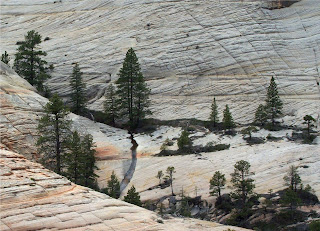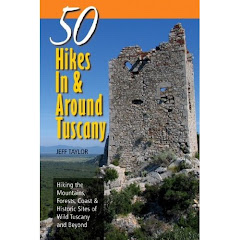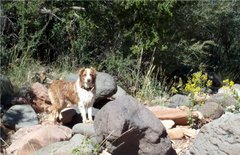
Distance: 15.2 km (9.4 mi)
Elevation: 1275-1970 m (4182 - 6461 ft)
Difficulty: Moderately Strenuous
Season: May-October

Inside the heart of the Parco Nazionale della Abruzzo in Central Italy is a wonderful town called Pescasseroli. From town look for a sign for Prato Rosso to the right. After crossing the bridge, take a left at the T-intersection and the road will soon turn to dirt (there is no sign at this turn). Follow the dirt road slowly uphill until reaching a chain link fenced area with a no car entry sign (red and white circle). Park here and begin walking up the road.

The road begins by entering a narrow notch in the rock, with beautiful large beech trees and interesting limestone formations, including boulders, grottos, and overhangs. Continue up the road through forests and occasional clearings, passing trail access for the A6 and A9, as well as, numerous smaller routes labeled with blue/white blazes that are not shown on any maps.

After about 3 km, you will read a small building on the left called refugio di Prato Rosso. Here, a dirt track will depart from the right and is labeled A4. Follow this track as it climbs up from the back of the valley toward the steep ridge. This track will continue for the next 1.4 km until reaching the beginning of the subalpine zone located at 1730 m.

Here you reach a T-intersection with another faint track. Stay right and follow the track as it heads towards a notch and alpine meadows above. Soon the view opens up into a spectacular alpine basin, with steep rocky slopes surrounding you in all directions. Continue following the track all the way to the back of the basin. Way-trails branch off in several places, but continue to the back of the valley and then follow the trail as it climbs up to the saddle at the top of the ridge.

Upon reaching the saddle, the view opens up across the expansive views most of the Abruzzi range and several valleys. If you turn right and follow the slope up to the summit, the views expand even further, taking in including Monte della Corte and Monte Marsicano, as well as, the nearby Majella range to the east.

Below the summit, it is possible to follow the ridgeline above and parallel to the way you came up. The view down into the basin you came up is incredible. Approximately 2/3 of the way back, a trail drops down the slope contouring the steep slopes until you reach the bottom of the basin once again. From here, retrace your steps back to the trailhead.



















































